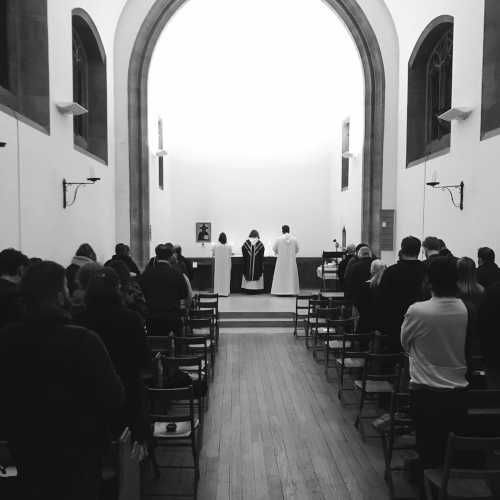
Last week, Westcott House tweeted the above image with the words:
On Thursday we celebrated our community eucharist facing east – and as well as recognising the different way we worship together when we face this way, we were encouraged to reflect on how it might conjure feelings of remoteness or distance from God, akin to Christ’s own feelings as he spent 40 days in the desert.
This tweet was later expanded, in a further tweet from Westcott House, by an image of a longer reflection. I did not think that the longer reflection added significantly to its summary in the above tweet. There was some good online reflection and discussion in response to this – but Westcott House then deleted both original tweets.
There continues to be reflections worth having, using the above as a springboard:
- Seminaries and Theological Colleges are places where appropriate, responsible experimentation should be able to safely happen: encountering what the Eucharist was like in Western Middle Ages, how this is celebrated by Orthodox, what Cranmer’s vision and implementation was actually like, etc. A lot of this can be done through videos, and acting things out, etc. Care needs to be taken when this becomes an actual worship event. Even greater care when this is shared internationally through social media. And the utmost care when that is via the official institutional social media platform.
- I question the exegesis that “Christ’s own feelings as he spent 40 days in the desert” were “akin to feelings of remoteness or distance from God”. There is nothing in the New Testament texts, that I can see, that indicate Jesus had the feelings thus described in those particular stories.
- The large tradition of Christians facing East to pray is not about “conjuring feelings of remoteness or distance from God”. This large tradition is about all facing in hope towards where the Sun rises. That the leader of prayer faces the same direction as all those being so led, is also not anything to do with remoteness or distance from God. At Taizé, for example, all face in the same direction – those leading, brothers, and the wider assembly. But there is no intention to have this orientation diminish a sense of the presence of God.
- The Eucharist is primarily about encountering, most intimately, the power, presence, and purpose of God – whether we feel that or not. It is not the vehicle to experiment to attempt to “conjure feelings of remoteness or distance from God”.
- The Eastward-facing tradition of presiding is understood by many to underscore the transcendence of God. But the transcendence of God is essential to the immanence of God as understood in the Christian tradition. God is closer to us than we are to ourselves because God transcends. A non-transcendent being can only be adjacent to us, can only come into contact with us and no further – it is God’s very transcendence that enables God to be be at our deepest point. It is God’s transcending of transcendence that is the Incarnation. This is the way that the human Jesus IS God. This is the way that the Eucharistic bread and wine IS Christ.
- To fairly experiment with replicating pre-Vatican II Eastward-facing presiding, the architecture needs to be part of experimenting. Facing an essentially bare, white wall is not fairly representative of traditional Eastward-facing presiding. I have seen other photos of that Westcott House wall – with beautiful images projected onto the wall.
- I am no advocate for Eastward-facing presiding. But I also think that Westward-facing presiding is too often VERY badly done – the sideboard-like altar has been pulled out from the East wall so that the priest can get behind it, and little else has been thought through. On occasion, there is half an empty church building between the presider behind the sideboard altar and the congregation! Little to nothing has been rethought or renewed in the pulling-out of the altar sideboard from the East wall.
I was delighted to note that Louis Weill was recently remembered for the “small square beautiful wood altar, built according to a new understanding of the community gathering around the altar as a table, rather than the over-sized coffin-shaped altars typical of so many Episcopal [Anglican] Churches.“
I have long been an advocate for a squarer-shaped altar.
And rather than the East-facing/West-facing dichotomy, I advocate for an architecture and renewed understanding of us all gathered around God’s altar table. Hence my coining in circuitu altaris (around the altar; in circuitu mensae around the table).



Thanks for this Bosco, interestingly at Taizé the Eucharist in the main church is celebrated facing the people. Al that has always felt rather awkward to me. When Br Pierre-Yves celebrates in the crypt he faces east with the few people present gathered around him in the apse. When I led the Quiet Day at Westcott last Friday I celebrated eastward with the congregation gathered closely at the altar and a simplified rite. The feedback was very positive on that and it was a good experience I think.
Thanks, Richard. Yes, I’ve been present at Taizé’s Eucharists – the change from the usual facing in the same direction for the majority of prayer times and the gathering around the altar table for Eucharist felt perfectly natural to me, as does facing the congregation when reading in that context, and continued simply in facing each other by distributor and communicant at Communion time. In which direction were the readings proclaimed at Westcott House when presiding is east-facing? Blessings.